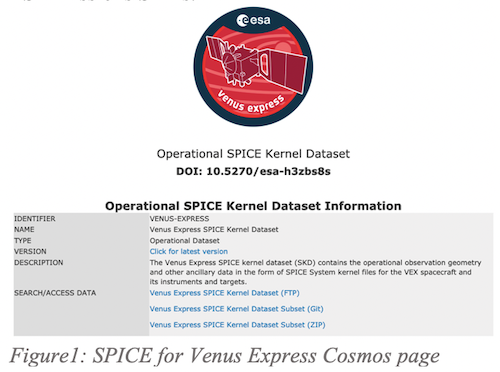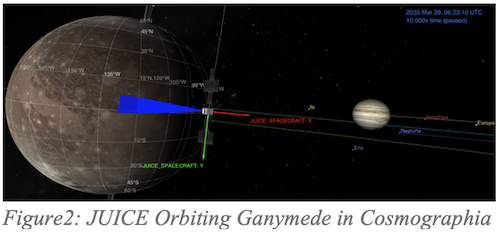Updates on SPICE for ESA Missions
- 1Rhea Systems for European Space Agency ESA/ESAC, Spain (alfredo.escalante.lopez@esa.int)
- 2European Space Agency ESA/ESAC
Introduction: SPICE is an information system the purpose of which is to provide scientists the observation geometry needed to plan scientific observations and to analyze the data returned from those observations. SPICE is comprised of a suite of data files, usually called kernels, and software -mostly subroutines [1]. The user incorporates a few of the subroutines into his/her own program that is built to read SPICE data and compute needed geometry parameters for whatever task is at hand. Some examples of geometry parameters typically computed are range or altitude, latitude and longitude, illuminations angles (phase, incidence and emission), instrument pointing and field-of-view calculations, reference frame transformations, and coordinate system conversions. SPICE is also very adept at time conversions.
The ESA SPICE Service: The ESA SPICE Service (ESS) leads the SPICE operations for ESA missions. The group generates the SPICE Kernel Datasets (SKDs) for missions in development (Hera, ExoMars 2022 and JUICE), missions in operations (Mars Express, ExoMars 2016, and BepiColombo) and legacy missions (Venus Express, Rosetta and SMART- 1). ESS is also responsible for the generation of SPICE Kernels for Solar Orbiter. The generation of SKDs includes the development and operation of software to convert ESA orbit, attitude, payload telemetry and spacecraft clock correlation data into the corresponding SPICE format. ESS also provides consultancy and support to the Science Ground Segments of the planetary missions, the Instrument Teams and the science community. The access point for the ESS activities, data and latest news can be found at the following site https://www.cosmos.esa.int/web/spice. ESS works in partnership with NAIF.
Providing the best data: The quality of the data contained on a SKD is paramount. Bad SPICE data can lead to the computation of wrong geometric quantities which can jeopardize science results. ESS, in collaboration with NAIF, is focused on providing the best SKDs possible. Kernels can be classified as Setup Kernels (FK kernels defining Reference Frames of a given S/C, IK kernels describing a given sensor field- of-view and other characteristics, PCK or Planetary Constants Kernels, and LSK or Leapseconds Kernels) and Time-varying Kernels (SPK and CK kernels providing Trajectory and Attitude data, SCLK providing Time Correlation Data, and MK or Meta- kernel). Setup kernels are iterated with the different agents involved in the determination of the data contained in those kernels (Instrument Teams, Science Ground Segments, etc.) while Time-varying kernels are automatically generated by the ESS SPICE Operational Pipeline to produce the Operational kernels that are used in the day-to-day work of the missions in operations (planning and data analysis). These Time-varying kernels are peer-reviewed a posteriori for the consolidation of SKDs that are archived in the PSA and PDS.
Status of the Kernel Datasets: The current status and latest developments of the SKDs for the before mentioned missions will be described in this contribution. In general, the ESS is reviewing the legacy and operational datasets and developing the ones for future missions. DOIs have been incorporated to both operational and archived datasets and shall be used for citing ESA missions SKDs.

SPICE Kernels Archived in the PSA. ESS is also responsible for the generation of PDS3 and PDS4 formatted SPICE Archives that are published by the PSA. ESS in close collaboration with NAIF, peer- reviews the operational kernels for the PSA [2] in order to publish being compliant with the Planetary Data System (PDS) standards and uses them in the processes that require geometry computations.
Extended Services: ESS offers other services beyond the generation and maintenance of SPICE Kernel Datasets, such as instances and configuration for WebGeocalc and Cosmographia for the ESA missions.
SPICE-Enhanced Cosmographia. NAIF offers for public use a SPICE-enhanced version of the open source visualization tool named Cosmographia. This is an interactive tool devoted to 3D visualizations of celestial bodies ephemerides and shape models, spacecraft trajectories and orientations, movable parts position, and instrument field-of-views and footprints. ESS provides the framework and configuration required to load the ESA missions in Cosmographia, this contribution will demonstrate its usage for the ESA Planetary missions [3].

WebGeocalc. The WebGeocalc tool (WGC) provides a web-based graphical user interface to many of the observation geometry computations available from the SPICE APIs. A WGC user can perform SPICE computations without the need to write a program; just a web browser is required. WGC is provided to the ESS by NAIF. This contribution will outline the WGC instances for ESA missions [3].
References: [1] Acton C. (1996) Planet. And Space Sci., 44, 65-70. [2] Bessel, S. et al., (2017) Planet. And Space Sci. [3] Acton, C. et al., (2017) Planet. And Space Sci.
How to cite: Escalante Lopez, A., Vallés Blanco, R., and Arviset, C.: Updates on SPICE for ESA Missions, European Planetary Science Congress 2021, online, 13–24 Sep 2021, EPSC2021-125, https://doi.org/10.5194/epsc2021-125, 2021.

